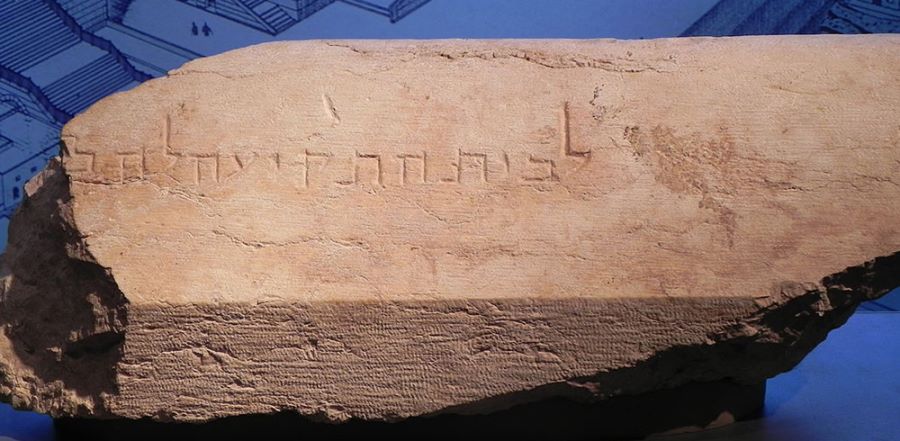"Sometimes a Rooster is Not a Rooster"
May 3, 2016 23:37:39 GMT -5
Post by J.J.Gibbs on May 3, 2016 23:37:39 GMT -5
"Sometimes a Rooster is Not a Rooster"
by Marc Turnage on May 2, 2016
Marc Turnage, the executive director of the Assemblies of God Center for Holy Lands Studies, provides a regular column to PE News that offers deep and sometimes surprising insight into the Word of God through close examination of the culture of the day, biblical sites, and archaeological records. In this article, he examines a well-known passage concerning Peter's denial of Christ and provides a surprising revelation about a "rooster" who crowed, but not in the way people have come to believe!
The cultural and spiritual world of ancient Judaism was the fabric from which the New Testament emerged. The Gospels contain details and information that reflect this cultural and spiritual reality, and often do not explain these details assuming their audience understood them. In several places, the earliest evidence of practices, ideas, and language found within Judaism appears within the Gospels. Quite often modern readers of the Gospels, unaware of the realities of ancient Judaism, miss such details. One example comes from the last hours of Jesus’ life. Jesus tells Peter, “the cock will not crow today before you deny three times that you know me” (Luke 22:34; see Matt. 26:34; Mark 14:30; John 13:38). Of course, Peter did deny Jesus three times before “cock crow” (Luke 22:60-61; Matt. 26:74-75; Mark 14:72; John 18:27).
Most readers assume Jesus’ statement referred to a rooster crowing in the early morning hours, and Peter’s actions preceded the rooster crow. It seems pretty clear and straightforward. That is, until we begin to step into the world of ancient Judaism.
The Mishnah, the earliest compilation of rabbinic oral law, states that roosters (chickens) may not be raised in Jerusalem due to purity concerns (m. Baba Kama 7.7; see also b. Baba Kama 82b). This decree comes from the first century, when the Temple stood in Jerusalem. So, if roosters were not permitted to be raised in Jerusalem, are the Gospels wrong?
The Greek term, alektor (Luke 22:34), which means, “cock,” can also mean “man, husband.” Thus, one can read the Greek of the Gospels as “the man will not cry out today before you deny three times that you know me.” This indicates that the Gospels did not mistakenly place a rooster in Jerusalem when roosters were not allowed to be raised in the city, but it does not answer the question as to what Jesus referred.
The ancient Jewish sources offer a solution. In describing the activities that went on in the Jerusalem Temple, the Mishnah references a specific time in the early morning: “He that was minded to clean the altar of ashes rose up early and immersed himself before the officer came. At what time did he come? Not always at the same time. Sometimes he came at cockcrow and sometimes a little sooner or later” (emphasis added; m. Tamid 1.2; see also m. Yoma 1.8; m. Sukkah 5.4). “Cockcrow” refers to a time early in the morning when the priests began to prepare the Temple for the daily visitors: “Every day they used to remove the ashes from off the altar at cockcrow, or near to it, either before it or after it” (m. Yoma 1.8). And it does not mean a rooster crow, but rather the blast from a trumpet at the Temple that announced the time: “At cockcrow they blew a sustained, a quavering, and another sustained blast” (m. Sukkah 5.4). In other words, cockcrow refers to a time early in the morning when a trumpet signaled the beginning of the day for work in the Temple.
The Hebrew expression for “cockcrow” is kerot hagever (lit. “the call of the cock”). The Hebrew word gever, translated as cock, also means “man,” like the Greek alektor. The Gospels, then, preserve the Jewish-Hebrew manner for speaking of the trumpet blast sounded from the Temple that announced to the priests it was time to begin preparing the Temple for the day. Jesus did not refer to a random rooster, but rather a specific time in the morning, which Peter would have understood. The Gospels also offer the earliest witness mentioning cockcrow in Jerusalem.
Excavations along the southwestern corner of the Temple Mount in Jerusalem uncovered a stone bearing a Hebrew inscription “to the place (lit. house) of trumpeting.” Scholars have suggested that this stone marked an area on the southwestern corner of the Temple Mount, facing towards the city, where priests would blow the trumpets announcing the different times of the day and week (see Josephus, War 4.582). It seems reasonable that this stone marked the location from which cockcrow sounded.
The Evangelists assumed that their readers understood the cultural and spiritual world of ancient Judaism; therefore, they did not explain much of the language and details. The task of the modern reader of the Gospels is to read the Gospels within the language, culture, and spiritual world of ancient Judaism because sometimes a rooster is not a rooster.
Editor's note: Marc Turnage has recently authored a revealing new book, Windows Into the Bible, which examines the New Testament from the historical and cultural context of those who were writing it. The book helps confirm the authenticity of Scripture.

Pictured: Stone excavated from the southwestern corner of the Temple Mount in Jerusalem, bearing the inscription "To the place of trumpeting."
link
by Marc Turnage on May 2, 2016
Marc Turnage, the executive director of the Assemblies of God Center for Holy Lands Studies, provides a regular column to PE News that offers deep and sometimes surprising insight into the Word of God through close examination of the culture of the day, biblical sites, and archaeological records. In this article, he examines a well-known passage concerning Peter's denial of Christ and provides a surprising revelation about a "rooster" who crowed, but not in the way people have come to believe!
The cultural and spiritual world of ancient Judaism was the fabric from which the New Testament emerged. The Gospels contain details and information that reflect this cultural and spiritual reality, and often do not explain these details assuming their audience understood them. In several places, the earliest evidence of practices, ideas, and language found within Judaism appears within the Gospels. Quite often modern readers of the Gospels, unaware of the realities of ancient Judaism, miss such details. One example comes from the last hours of Jesus’ life. Jesus tells Peter, “the cock will not crow today before you deny three times that you know me” (Luke 22:34; see Matt. 26:34; Mark 14:30; John 13:38). Of course, Peter did deny Jesus three times before “cock crow” (Luke 22:60-61; Matt. 26:74-75; Mark 14:72; John 18:27).
Most readers assume Jesus’ statement referred to a rooster crowing in the early morning hours, and Peter’s actions preceded the rooster crow. It seems pretty clear and straightforward. That is, until we begin to step into the world of ancient Judaism.
The Mishnah, the earliest compilation of rabbinic oral law, states that roosters (chickens) may not be raised in Jerusalem due to purity concerns (m. Baba Kama 7.7; see also b. Baba Kama 82b). This decree comes from the first century, when the Temple stood in Jerusalem. So, if roosters were not permitted to be raised in Jerusalem, are the Gospels wrong?
The Greek term, alektor (Luke 22:34), which means, “cock,” can also mean “man, husband.” Thus, one can read the Greek of the Gospels as “the man will not cry out today before you deny three times that you know me.” This indicates that the Gospels did not mistakenly place a rooster in Jerusalem when roosters were not allowed to be raised in the city, but it does not answer the question as to what Jesus referred.
The ancient Jewish sources offer a solution. In describing the activities that went on in the Jerusalem Temple, the Mishnah references a specific time in the early morning: “He that was minded to clean the altar of ashes rose up early and immersed himself before the officer came. At what time did he come? Not always at the same time. Sometimes he came at cockcrow and sometimes a little sooner or later” (emphasis added; m. Tamid 1.2; see also m. Yoma 1.8; m. Sukkah 5.4). “Cockcrow” refers to a time early in the morning when the priests began to prepare the Temple for the daily visitors: “Every day they used to remove the ashes from off the altar at cockcrow, or near to it, either before it or after it” (m. Yoma 1.8). And it does not mean a rooster crow, but rather the blast from a trumpet at the Temple that announced the time: “At cockcrow they blew a sustained, a quavering, and another sustained blast” (m. Sukkah 5.4). In other words, cockcrow refers to a time early in the morning when a trumpet signaled the beginning of the day for work in the Temple.
The Hebrew expression for “cockcrow” is kerot hagever (lit. “the call of the cock”). The Hebrew word gever, translated as cock, also means “man,” like the Greek alektor. The Gospels, then, preserve the Jewish-Hebrew manner for speaking of the trumpet blast sounded from the Temple that announced to the priests it was time to begin preparing the Temple for the day. Jesus did not refer to a random rooster, but rather a specific time in the morning, which Peter would have understood. The Gospels also offer the earliest witness mentioning cockcrow in Jerusalem.
Excavations along the southwestern corner of the Temple Mount in Jerusalem uncovered a stone bearing a Hebrew inscription “to the place (lit. house) of trumpeting.” Scholars have suggested that this stone marked an area on the southwestern corner of the Temple Mount, facing towards the city, where priests would blow the trumpets announcing the different times of the day and week (see Josephus, War 4.582). It seems reasonable that this stone marked the location from which cockcrow sounded.
The Evangelists assumed that their readers understood the cultural and spiritual world of ancient Judaism; therefore, they did not explain much of the language and details. The task of the modern reader of the Gospels is to read the Gospels within the language, culture, and spiritual world of ancient Judaism because sometimes a rooster is not a rooster.
Editor's note: Marc Turnage has recently authored a revealing new book, Windows Into the Bible, which examines the New Testament from the historical and cultural context of those who were writing it. The book helps confirm the authenticity of Scripture.

Pictured: Stone excavated from the southwestern corner of the Temple Mount in Jerusalem, bearing the inscription "To the place of trumpeting."
link



